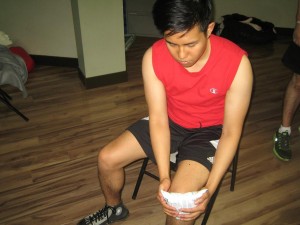In sports, sprains typically affect athletes but can easily occur to anybody. Sprains are best described as injuries to the ligaments that can range in severity from a minor stretch or even a serious tear that would require medical intervention. [youtube url=”https://www.youtube.com/watch?v=2y4D155qLc8″ width=”220″]
Signs and symptoms of a sprain
When treating individuals with a sprain, you have to check first if there are signs of swelling, discoloration, pain, instability in the affected joint. Other symptoms include inability to move the affected joint, severe pain, tenderness in the injured area, deformity of the bones and a popping sound. If you suspect that an individual has a sprain, immobilize the injured part.
Treatment for sprains
When it comes to the treatment of sprains, first you have to provide the individual with plenty of liquids to drink to prevent dehydration. If the sprain is severe especially in sports, the individual is given ibuprofen, but it is still recommended to consult the doctor for the right dosage. Instruct the individual not to move the affected area to prevent further complications.

Apply an ice bag or cold compress for 20 to 40 minutes every 2-4 hours for the first 24 to 48 hours after the injury. By applying ice on the affected part, it will hasten the healing process of the injury. The next step is to wrap the affected area using an elastic bandage in order to prevent further swelling. Just be careful not to cut off the circulation of the blood. Elevate the injured part above the level of the heart since it will also reduce the swelling. Lastly, rewarm the affected area for 10-15 minutes then assess the swelling after providing HI-RICE (hydration, ibuprofen, rest, ice, compression and elevation). Last thing you perform is to apply heat on the affected area after 3 days so that the healing process will be hastened.
Important considerations to bear in mind
When handling sprains, you have to take into consideration the following first aid measures during the treatment process.
- Place crushed ice in a plastic bag or ice bag. Other alternatives is to soak the affected part in cold water or use a chemical cooling pack, if ice is not available. This cooling pack is a plastic sac of ice or refrigerated gel or liquid. Both the ice pack and the non-toxic gel which is mostly water absorb heat due to the fusion of water. These packs can be used as a cold compress to lessen the pain of minor injuries such as sprain or fracture. You can also wrap the injured part in a thin cloth and the evaporation will cool it
- Wrap the ice with a cloth or plastic before placing to the injured part. Do not place the ice directly to the injury since this can cause further injury.
